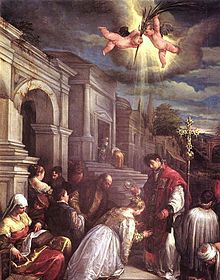Lupercalia
There is no evidence of any link between St. Valentine's Day and the rites of the ancient Roman festival, despite many claims by many authors. The celebration of Saint Valentine did not have any romantic connotations until Chaucer's poetry about "Valentines" in the 14th century.
Popular modern sources claim links to unspecified Greco-Roman February holidays alleged to be devoted to fertility and love to St. Valentine's Day, but prior to Chaucer in the 14th century, there were no links between the Saints named Valentinus and romantic love. Earlier links as described above were focused on sacrifice rather than romantic love. In the ancient Athenian calendar the period between mid-January and mid-February was the month of Gamelion, dedicated to the sacred marriage of Zeus and Hera.
In Ancient Rome, Lupercalia, observed February 13–15, was an archaic rite connected to fertility. Lupercalia was a festival local to the city of Rome. The more general Festival of Juno Februa, meaning "Juno the purifier "or "the chaste Juno", was celebrated on February 13–14. Pope Gelasius I (492–496) abolished Lupercalia. Some researchers have theorized that Gelasius I replaced Lupercalia with the celebration of the Purification of Mary in February 14 and claim a connection to the 14th century's connotations of romantic love, but there is no historical indication that he ever intended such a thing. Also, the dates don't fit because at the time of Gelasius I the feast was only celebrated in Jerusalem, and it was on February 14 only because Jerusalem placed the Nativity on January 6. Although it was called "Purification of Mary", it dealt mainly with the presentation of Jesus at the temple. The Jerusalem's Purification of Mary on February 14 became the Presentation of Jesus at the Temple on February 2 as it was introduced to Rome and other places in the sixth century, after Gelasius I's time.
Alban Butler in his Lifes of the Principal Saints (1756–1759) claimed without proof that men and women in Lupercalia drew names from a jar to make couples, and that modern Valentine's letters originated from this custom. In reality, this practice originated in the Middle Ages, with no link to Lupercalia, with men drawing the names of girls at random to couple with them. This custom was combated by priests, for example by Frances de Sales around 1600, apparently by replacing it with a religious custom of girls drawing the names of apostles from the altar. However, this religious custom is recorded as soon as the 13th century in the life of Saint Elizabeth of Hungary, so it could have a different origin.
Historical facts
Numerous early Christian martyrs were named Valentine. The Valentines honored on February 14 are Valentine of Rome (Valentinus presb. m. Romae) and Valentine of Terni (Valentinus ep. Interamnensis m. Romae). Valentine of Rome was a priest in Rome who was martyred about AD 496 and was buried on the Via Flaminia. The relics of Saint Valentine were kept in the Church and Catacombs of San Valentino in Rome, which "remained an important pilgrim site throughout the Middle Ages until the relics of St. Valentine were transferred to the church of Santa Prassede during the pontificate of Nicholas IV".The flower-crowned skull of Saint Valentine is exhibited in the Basilica of Santa Maria in Cosmedin, Rome. Other relics are found at Whitefriar Street Carmelite Church in Dublin, Ireland. Valentine of Terni became bishop of Interamna (modern Terni) about AD 197 and is said to have been martyred during the persecution under Emperor Aurelian. He is also buried on the Via Flaminia, but in a different location than Valentine of Rome. His relics are at the Basilica of Saint Valentine in Terni (Basilica di San Valentino). Jack B. Oruch states that "abstracts of the acts of the two saints were in nearly every church and monastery of Europe.
February 14 is celebrated as St. Valentine's Day in various Christian denominations; it has, for example, the rank of 'commemoration' in the calendar of saints in the Anglican Communion. In addition, the feast day of Saint Valentine is also given in the calendar of saints of the Lutheran Church. However, in the 1969 revision of the Roman Catholic Calendar of Saints, the feast day of Saint Valentine on February 14 was removed from the General Roman Calendar and relegated to particular (local or even national) calendars for the following reason: "Though the memorial of Saint Valentine is ancient, it is left to particular calendars, since, apart from his name, nothing is known of Saint Valentine except that he was buried on the Via Flaminia on February 14." The feast day is still celebrated in Balzan (Malta) where relics of the saint are claimed to be found, and also throughout the world byTraditionalist Catholics who follow the older, pre-Second Vatican Council calendar. In the Eastern Orthodox Church, St. Valentine's Day is celebrated onJuly 6, in which Saint Valentine, the Roman presbyter, is honoured; furthermore, the Eastern Orthodox Church obsesrves the feast of Hieromartyr Valentine, Bishop of Interamna, on July 30.

No comments:
Post a Comment